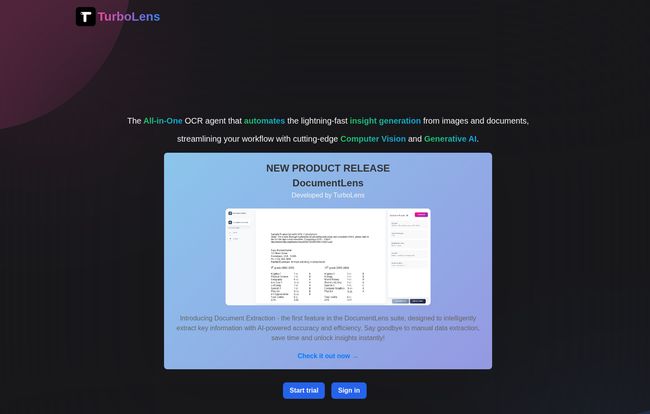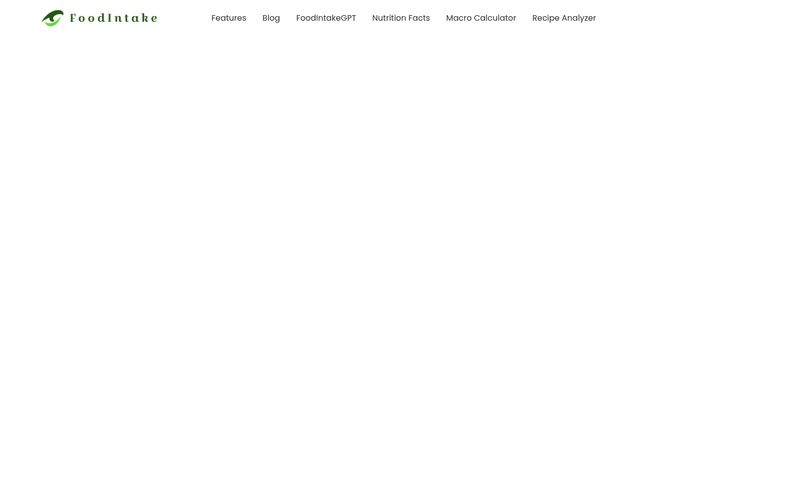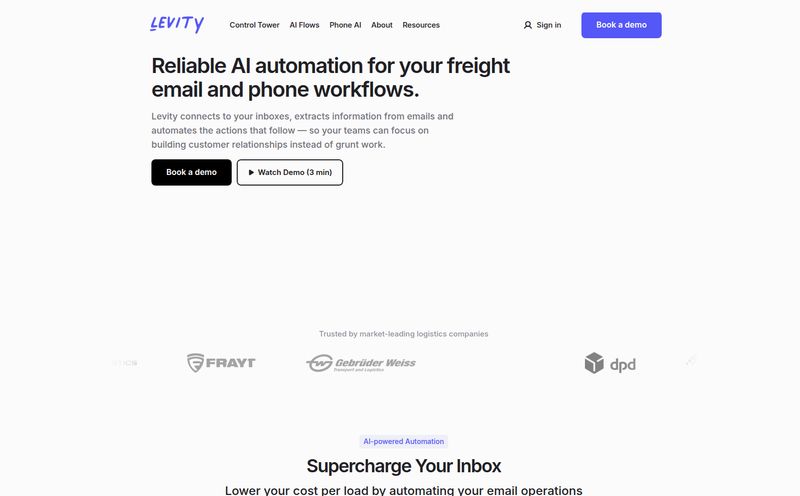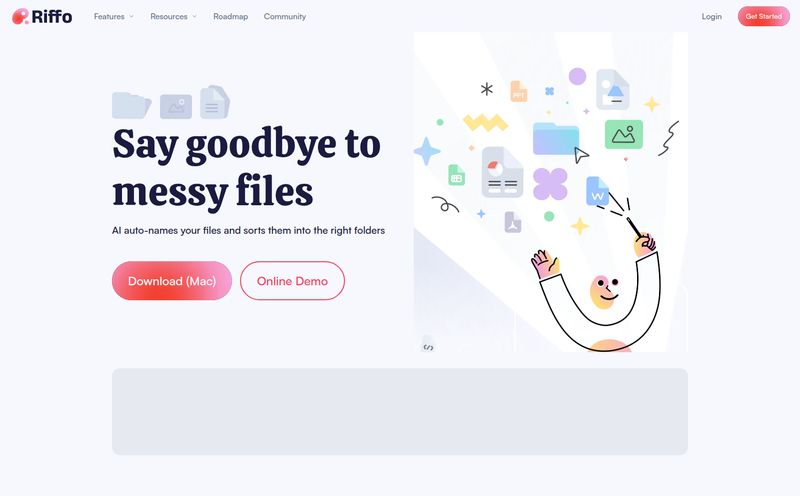We’ve all been there. Staring at a screenshot of a brilliant quote, a scanned PDF from the dark ages of office tech, or a photo of a restaurant menu in a language you definitely didn't learn in school. The information is right there, trapped behind a glass wall of pixels. And so begins the tedious, soul-crushing task of manually typing it all out. It feels like trying to chip words out of a stone tablet with a plastic spoon.
For years, Optical Character Recognition (OCR) tools promised to be our savior. And for years, they’ve been… well, a bit rubbish. They’d trip over a slightly weird font, mistake an ‘l’ for a ‘1’, and completely fall apart if you showed them a table. But the tech has been quietly getting smarter. A lot smarter. And recently, a tool called TurboLens popped onto my radar, and I have to say, I'm genuinely impressed.
So, I decided to take it for a spin. Is it just another overhyped AI gadget, or is it the real deal for slaying the data entry dragon? Let's get into it.
What is TurboLens, Anyway?
In the simplest terms, TurboLens is an AI-powered agent that reads text, tables, and even handwriting from images and documents. Think of it as a universal translator for visual information. You feed it a picture, and it gives you back usable, editable data. Its whole pitch is about providing “instant insight generation,” which is a fancy way of saying it saves you a ton of time and frustration.
But it's not just about simple text grabbing. It aims to be an all-in-one platform, which always makes my inner skeptic raise an eyebrow. Can it really do it all well? That's what I wanted to find out.
The Features That Actually Matter
A tool is only as good as its features, and TurboLens splits its skills into a few key areas. Some are fully-fledged, others are in a “preview” stage, which is tech-speak for “use at your own risk, but it’s cool.”
OmniExtract for Everyday Text Grabs
This is your bread-and-butter OCR. I threw everything I could find at it: clean screenshots of code, blurry photos of book pages, and old, grainy PDFs. For the most part, OmniExtract did a fantastic job. It's the workhorse of the platform, designed for that quick and easy copy-paste from an image you can't otherwise interact with. Nothing revolutionary, but it needs to be solid, and it is.
Can It Read My Doctor’s Handwriting? Enter ScriptExtract
Okay, this is where things get interesting. Handwriting recognition is notoriously difficult. My own notes look like a seismograph reading during an earthquake. So, I was curious about ScriptExtract. I fed it some old handwritten letters and some (relatively neat) meeting notes. The results? Surprisingly good. It's not 100% perfect—it struggled with a few particularly flamboyant cursive letters—but it was more than enough to get the gist without deciphering every single character myself. I wouldn't bet my life on it reading a doctor's prescription, but for historical documents, personal archives, or digitizing study notes, its pretty darn cool.
PixelTrans is a Content Creator's Dream
Now this. This is the feature that made me sit up straight. We’ve had text translators for ages, right? But what about when that text is part of an image, like an infographic, an ad, or a comic strip? Normally, you'd have to extract the text, translate it, then painstakingly rebuild the entire graphic in Photoshop. It's a massive pain.
PixelTrans changes that. It translates the text while preserving the original image's layout. You give it an image with Japanese text, and it gives you back the same image, but with English text in the same spot, in a similar font and color. It's like having a design-savvy linguist on call 24/7. For marketers, social media managers, or anyone working with international content, this feature alone could be worth the price of admission. It’s not just a tool; it feels a little bit like magic.

Visit TurboLens
A Glimpse into the Future: GridExtract and QuizExtract
These two are still in preview, but they show the platform's ambition. GridExtract is designed to pull tables from an image and convert them straight into a usable Excel format. Think of financial reports, scientific papers, or product comparison sheets. Anyone who’s ever had to re-type a 50-row table knows the immense value here. QuizExtract is more niche, transforming quizzes into LaTeX code, which is a big deal for academics and educators who live in that ecosystem. They're not the main event yet, but they’re a promising peek at what's to come.
The Good, The Bad, and The Pricey
No tool is perfect, and a real review needs to cover the whole picture. After using TurboLens for a bit, a few things stood out, for better and for worse.
What I Liked
The AI-powered accuracy is a clear winner. It's fast and, for the most part, reliable. The multi-language support, especially within PixelTrans, is fantastic. Having a single platform that can handle plain text, handwriting, tables, and full-on image translation is a massive workflow improvement. You're not jumping between three different apps to get one job done.
The Not-So-Great Stuff
The biggest catch is the quota system on the free plan. You get 10 daily uses for the main features. That's enough for a test drive or very occasional use, but you'll hit that wall fast if you have a real project. Secondly, the preview features are just that—previews. They might have bugs or limitations, so you can't build a critical workflow around them just yet. And, of course, the price for the unlimited plan might be a hurdle for freelancers or small businesses just starting out.
Let's Talk Money: TurboLens Pricing
The pricing structure is pretty straightforward, which I appreciate. No confusing credit systems or weird add-ons.
- Free Plan: $0/month gets you 10 daily uses each for OmniExtract, ScriptExtract, and PixelTrans. It's a great way to see if the tool works for your specific needs without pulling out your credit card.
- Individual Plan: This will set you back $49.90 per month. For that, you get unlimited use of the core tools, plus 300 monthly uses for the preview features (GridExtract and QuizExtract) and batch processing. This is aimed at the power user—the marketer, the researcher, the data professional.
- Enterprise Plan: This is a “contact us for a quote” deal. It’s for large teams or companies that need customized solutions, dedicated support, and all the bells and whistles.
My take? The free plan is genuinely useful for trying it out. The Individual plan’s value really depends on how often you'll use that PixelTrans feature or if you're doing batch processing. If you save even a few hours of design or data entry work a month, it probably pays for itself.
Who is TurboLens Actually For?
So who should be sprinting to sign up? I see a few key groups.
Marketers and Content Creators will love PixelTrans for localizing campaigns. Researchers and Academics will find huge value in ScriptExtract for archives and GridExtract for data papers. Students can digitize lecture notes and textbook excerpts in a snap. And of course, Data Entry professionals can automate a huge chunk of their workload.
If you only need to grab text from a screenshot once in a blue moon, it might be overkill. But for anyone who regularly deals with information locked in images, it's a serious contender.
Frequently Asked Questions about TurboLens
Q1: How accurate is the handwriting recognition really?
It's very good with relatively neat print or cursive, but it can struggle with highly stylized or messy handwriting. I'd say it's about 85-95% accurate on decent source material. Always best to proofread!
Q2: Can TurboLens handle languages other than English?
Yes. The multi-language OCR is one of its main strengths, particularly in the PixelTrans feature, which is designed specifically for translating text within images across different languages.
Q3: Is the free version of TurboLens good enough to use regularly?
It depends on your needs. For very light, occasional use—like grabbing a quote here and there—the 10 daily credits are probably fine. For any kind of consistent project or professional work, you'll likely need to upgrade to the Individual plan.
Q4: Does TurboLens translate the text within the image?
Yes, that's the primary function of the PixelTrans feature. It detects text in an image, translates it, and then places the translated text back into the image, preserving the original's visual style and layout.
Q5: What's the main difference between OmniExtract and GridExtract?
OmniExtract is for grabbing general text from any part of an image. GridExtract is a specialized tool specifically designed to recognize the structure of a table (rows and columns) and export that data directly into a structured format like an Excel file.
My Final Thoughts on This OCR Powerhouse
So, is TurboLens worth it? In my experience, yes. It's a powerful, modern, and surprisingly versatile OCR tool that gets a lot of things right. It’s moved beyond simple text extraction into the realm of intelligent document processing.
The platform isn't perfect—the reliance on preview features for some advanced functions and the quota on the free plan are things to be aware of. But the core functionality is solid, and features like PixelTrans are genuine game-changers for certain professions. It's a sharp, well-designed tool that does exactly what it says on the tin: it saves you a monumental amount of time by turning dead pixels into living, breathing data. And in this line of work, time is everything.



